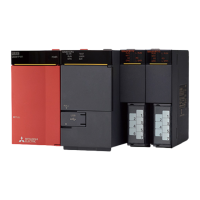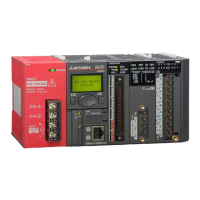474
7 APPLICATION INSTRUCTION
7.10 Data control instruction
Upper and lower limit control of 32-bit binary data
DLIMIT(P)(_U)
These instructions control the output value to be stored in the device specified by (d) by checking the input value (32-bit binary
data) in the device specified by (s3) with the upper and lower limit values specified by (s1) and (s2).
*1 The DLIMIT(_U) instructions are not supported by the ST language. Use LIMIT of the standard function.
Page 806 LIMIT(_E)
■Descriptions, ranges, and data types
■Applicable devices
• These instructions control the output value to be stored in the device specified by (d) by checking the input value (32-bit
binary data) in the device specified by (s3) with the upper and lower limit values specified by (s1) and (s2). The output value
is controlled as follows.
• To control the input value only with the upper limit, set the minimum value within the setting range in (s1).
• To control the input value only with the lower limit, set the maximum value within the setting range in (s2).
Ladder diagram Structured text
*1
ENO:=DLIMITP(EN,s1,s2,s3,d); ENO:=DLIMITP_U(EN,s1,s2,s3,d);
Operand Description Range Data type Data type (label)
(s1) DLIMIT(P) Lower limit value (minimum output value) -2147483648 to +2147483647 32-bit signed binary ANY32
DLIMIT(P)_U 0 to 4294967295 32-bit unsigned binary
(s2) DLIMIT(P) Upper limit value (maximum output value) -2147483648 to +2147483647 32-bit signed binary ANY32
DLIMIT(P)_U 0 to 4294967295 32-bit unsigned binary
(s3) DLIMIT(P) Input value controlled by the upper and lower
limit values
-2147483648 to +2147483647 32-bit signed binary ANY32
DLIMIT(P)_U 0 to 4294967295 32-bit unsigned binary
(d) DLIMIT(P) Head device number storing the output value
controlled by the upper and lower limit values
32-bit signed binary ANY32
DLIMIT(P)_U 32-bit unsigned binary
Operand Bit Word Double word Indirect
specification
Constant Others
X, Y, M, L,
SM, F, B, SB
U\G T, ST,
C, LC
T, ST, C, D,
W, SD, SW, R
U\G Z LC LZ K, H E $
(s1)
(s2)
(s3)
(d)
Condition Output value
Lower limit value ((s1), (s1)+1) > Input value ((s3), (s3)+1) Lower limit value ((s1), (s1)+1)
Upper limit value ((s2), (s2)+1) < Input value ((s3), (s3)+1) Upper limit value ((s2), (s2)+1)
Lower limit value ((s1), (s1)+1) Input value ((s3), (s3)+1) Upper limit value ((s2), (s2)+1) Input value ((s3), (s3)+1)
0
Output value (d+1, d)
Input value (s3+1, s3)
Lower limit value (s1+1, s1)
Upper limit value (s2+1, s2)

